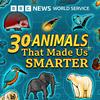63 épisodes

Insects and mobile phone
17/1/2022 | 20 min
S2 Ep 30. Smart phones could become even smarter – thanks to ants, beetles, moths and spiders! A multi-animal special episode, marking the season 2 finale. Patrick explores what could be an insect inspired phone of the future! There’s the story of the fire ants and bark beetles and a new camera lens with a much greater field of view. The hairs on butterflies, moths and spiders could help with an amazing new microphone. Moths might make it easier to look at our phones in bright sunlight. There’s also a waterproof, anti-bacterial cover which could be based on the wings of cicadas. Thanks for listening and please help us spread the word. #30Animals

Butterfly and eye implant
10/1/2022 | 17 min
S2 Ep 29. Not all butterflies are colourful. The transparent wings of the longtail glasswing butterfly may hold the key to more effective eye implants. This could be of huge benefit to people with glaucoma - the second leading cause of blindness in the world. Get in touch: www.bbcworldservice.com/30animals #30Animals

Slug and surgical glue
03/1/2022 | 17 min
S2 Ep 28. From goo to super glue! Slug slime may hold the key to mending wounds without stitches or staples. Scientists have developed new adhesives based on the properties of slug slime, that are as sticky as any glue, stretchier than a rubber band and aren’t toxic to humans. This sticky substance could be used to repair a delicate organ like the heart or lung without using methods that could damage the organ. Get in touch: www.bbcworldservice.com/30animals #30Animals

Dragonfly and sky spy
27/12/2021 | 15 min
S2 Ep 27. The amazing agility of a dragonfly leads to the creation of a new spy drone. Their four wings can move independently of each other, enabling them to fly forwards, backwards, sideways, up and down and suddenly stop and hover like a helicopter. This caught the attention of engineers who wanted to develop a small drone that could be used by the military as a spying device. In the future, this sort of technology might send back pictures from areas where it’s too dangerous for humans to go. Get in touch: www.bbcworldservice.com/30animals #30Animals

Kingfisher and soil erosion
20/12/2021 | 14 min
S2 Ep 26. A very clever solution to a significant environmental problem based on a kingfisher’s eyelids. When the brightly coloured bird dives for food, its eyes are covered in a way that protects the kingfisher’s eyeballs, rather like swimming goggles protect ours. Architects have copied this design to help prevent soil erosion on the banks of the huge Three Gorges Dam in China. Get in touch: www.bbcworldservice.com/30animals #30Animals
Plus de podcasts Technologies
Podcasts tendance de Technologies
À propos de 30 Animals That Made Us Smarter
Écoutez 30 Animals That Made Us Smarter, Underscore_ ou d'autres podcasts du monde entier - avec l'app de radio.fr

Obtenez l’app radio.fr gratuite
- Ajout de radios et podcasts en favoris
- Diffusion via Wi-Fi ou Bluetooth
- Carplay & Android Auto compatibles
- Et encore plus de fonctionnalités
Obtenez l’app radio.fr gratuite
- Ajout de radios et podcasts en favoris
- Diffusion via Wi-Fi ou Bluetooth
- Carplay & Android Auto compatibles
- Et encore plus de fonctionnalités


30 Animals That Made Us Smarter
Téléchargez l’app,
Écoutez.






































